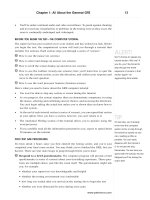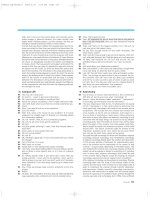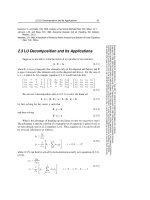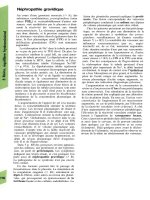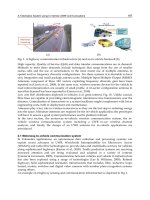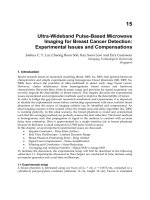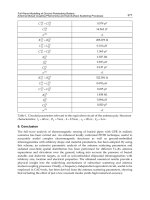Atlas of the Diabetic Foot - part 4 doc
Bạn đang xem bản rút gọn của tài liệu. Xem và tải ngay bản đầy đủ của tài liệu tại đây (818.47 KB, 22 trang )
64 Atlas of the Diabetic Foot
Figure 3.33 Callus over prominence of metatarsal head
from retinopathy or nephropathy, but he
had severe diabetic neuropathy. On exami-
nation a callus was present under the head
of his right third metatarsal, which caused
minor discomfort (Figure 3.33). Another
bony prominence was evident on the outer
aspect of his fifth metatarsal, without cal-
lus formation. Claw toes, onychomycosis
and dry skin were also present. The callus
was removed, and a tiny superficial ulcer
revealed. The patient was prescribed extra
depth shoes with orthotic insoles (preven-
tive footwear). Hydrating cream was used
to prevent skin cracking.
Keywords: Callus; claw toes; dry skin
CALLUS OVER PROMINENT
METATARSAL HEADS
A 70-year-old female patient who had type
2 diabetes since the age of 50 years and
was being treated with insulin, attended
the foot clinic for chiropody treatment. She
had a history of ischemic heart disease
(myocardial infarction and stroke), periph-
eral vascular disease treated with low dose
Anatomical Risk Factors for Diabetic Foot Ulceration 65
of aspirin; and proliferative retinopathy.
She complained of numbness in both feet
and a deep aching pain in her calves and
painful heel cracks.
On examination, peripheral pulses were
absent and her ankle brachial index was 0.8
on the left and 0.7 on the right. The vibra-
tion perception threshold was 30 V in both
feet. Achilles tendon reflexes were absent,
and pain, temperature, light touch and
vibration sensation were severely dimin-
ished. Pes cavus and hallux valgus were
present on both feet (most prominent on
the left), together with an obvious promi-
nence of her metatarsal heads and callus
formation. The fat pads of her metatarsal
heads were translocated towards the toes.
The skin on her feet was dry (Figure 3.34).
The calluses were debrided on a regular
basis, and appropriate footwear was pre-
scribed. Heel cracks (see Figure 4.6)per-
sisted despite debridement.
Calluses develop in areas of high pres-
sure in the feet as a physiological reaction
of the skin in response to loading. A callus
adds further pressure to the underlying tis-
sues functioning as a foreign body under the
foot. Prospective studies have shown that
regular removal of calluses reduces the risk
of foot ulceration.
Keywords: Prominent metatarsal heads;
callus
HEMORRHAGIC CALLUS
A 64-year-old male patient with type 2
diabetes diagnosed at the age of 47 years
attended the outpatient diabetic foot clinic
because of an ulcer under his right foot.
On examination, a painless ulcer sur-
rounded by a hemorrhagic callus was
seen under the third metatarsal head
(Figure 3.35). Claw toe deformity, a curly
Figure 3.35 A neuropathic ulcer under a hem-
orrhagic callus
Figure 3.34 Callus over prominence
on metatarsal heads. Pes cavus and hal-
lux valgus
66 Atlas of the Diabetic Foot
fourth toe, and a heloma molle in the fourth
interdigital space were also observed. The
patient had bounding peripheral pulses and
severe peripheral neuropathy. After sharp
debridement of his callus, an ulcer of
dimensions 2.0 × 1.5 cm and depth 1 cm
was revealed. Plantar fascia was exposed.
A plain radiograph excluded osteomyelitis.
The patient was instructed in foot care.
Offloading of the ulcer area was achieved
by the use of an ‘almost half’ shoe
(Figure 3.36) and a total-contact orthotic
insole, with a window under the ulcer area.
These shoes cause instability, so the patient
was instructed to use a crutch. The ulcer
healed completely in 8 weeks.
The cause of the ulcer in this patient was
high plantar pressure under his prominent
metatarsal heads (Figure 3.37). After the
ulcer had healed, protective footwear (extra
depth shoes and custom-made insoles) was
prescribed in order to reduce the peak
pressure on the third metatarsal head. No
relapse of the ulcer occurred in the subse-
quent months.
Keywords: Hemorrhagic callus; half shoes;
protective footwear
Figure 3.36 Therapeutic half shoe for the
treatment of forefoot ulcers
ULCER UNDER A CALLUS
AREA
A 70-year-old male patient with longstand-
ing type 2 diabetes attended the outpa-
tient diabetic foot clinic for callus removal
on his right foot. On examination, a neu-
ropathic ulcer surrounded by callus was
noticed under his fourth metatarsal head
(Figure 3.38). He had normal peripheral
pulses and severe peripheral neuropathy.
Claw toes, varus deformity of the foot and
prominent metatarsal heads on his right foot
Figure 3.37 Peak plantar pressures recorded with a pedobarograph
Anatomical Risk Factors for Diabetic Foot Ulceration 67
were observed. Discoloration of the skin
on the lower tibia due to venous insuffi-
ciency was also evident. The callus was
debrided. Shoes and insoles similar to those
shown in Figure 3.36 were prescribed until
the ulcer healed. The cause of the ulcer in
this patient was the callus resulting from
high plantar pressures. High peak pressures
are present in almost all cases where there
are prominent metatarsal heads due to claw
toe deformity. Prevention of callus forma-
tion is necessary to avoid recurrence of the
ulcer. Protective footwear was prescribed
after the ulcer had healed.
Keywords: High plantar pressure; cal-
lus, prominent metatarsal heads; varus de-
formity
Figure 3.38 A neuropathic ulcer under a callus
ULCER UNDER HALLUX
A 70-year-old male patient with longstand-
ing type 2 diabetes treated with insulin
and sulfonylurea, attended the outpatient
diabetic foot clinic because of a hemor-
rhagic callus under the phalangophalangeal
joint of the right hallux (Figure 3.39).
He had ischemic heart disease, hyperten-
sion, peripheral vascular disease, back-
ground retinopathy and microalbuminuria.
The patient had severe diabetic neuropa-
thy; the ankle brachial index was 0.7. After
his callus was debrided a clean neuro-
ischemic ulcer was revealed. A plain radio-
graph excluded osteomyelitis. Therapeu-
tic footwear was prescribed and the ulcer
healed in 6 weeks.
The forefoot is the usual site for ulcer-
ation. In one series, ulcers of the fore-
foot accounted for 93% of all foot ulcers.
Almost 20% of the ulcers developed under
the hallux, 22% over the metatarsal heads,
26% on the tips of the toes and 16% on the
dorsum of the toes. Ulcer under the hal-
lux is associated with rigid hallux and high
peak pressures on this area.
Keywords: Hemorrhagic callus; prevalence
of foot ulceration
HEEL CRACKS
Painful heel cracks due to dry skin were
noted in the patient whose feet are shown
in Figure 3.34 (Figure 3.40).
Dry skin in diabetic patients is caused
by sympathetic cholinergic denervation of
the sweat glands in their feet. Patients with
dry foot skin often develop reactive hyper-
hydrosis of the upper body. Heel cracks
68 Atlas of the Diabetic Foot
Figure 3.39 Hemorrhagic callus under the hallux
Figure 3.40 Heel cracks
may become infected and may lead to deep
ulcers with calcaneous involvement if left
untreated. The crack resists healing, despite
the correct foot care. Heel cracks are aggra-
vated by microvascular disease and neu-
ropathy, and resist healing, despite adequate
foot care. Local application of hydrating
creams — avoiding the areas between the
toes — is the treatment which is usually
recommended.
Keywords: Dry skin; heel cracks
BILATERAL CHOPART
DISARTICULATION
A 73-year-old male patient with type 2
diabetes diagnosed at the age of 61 years
attended the outpatient diabetes foot clinic
for a chronic ulcer under his left par-
tially amputated foot. He had had bilateral
mid-tarsal (Chopart) disarticulations (on the
right foot at the age of 66 years and on
the left foot at the age of 68 years) because
Anatomical Risk Factors for Diabetic Foot Ulceration 69
of infected foot ulcers under the metatarsal
heads complicated by osteomyelitis.
On examination, his feet pulses were
palpable, but the patient had severe periph-
eral neuropathy. A full thickness neuro-
pathic ulcer, which developed 2 months
after the amputation, was evident on the
plantar area of the left foot (Figure 3.41).
The patient had never used any ankle pros-
thesis or orthosis, but instead used crutches
and shoes with a firm outsole and a soft
molded insert. The ulcer healed for a period
of only 2 months, when the patient was
hospitalized because of a hip fracture.
Chopart disarticulation is performed
through the talonavicular and calcaneocu-
boid joints, preserving the hindfoot only
(talus and calcaneus). As no muscles attach
to the talus, all active dorsiflexion of the
remaining short foot is lost. However,
dorsiflexion can be restored, by reattaching
the anterior tibial tendon to the neck of the
talus. Chopart disarticulation preserves the
normal length of the leg and the patient
can undertake limited walking without a
prosthesis. Reasonable walking is possible
by the use of an intimately fitting fixed-
ankle prosthesis or orthosis placed into a
shoe with a rigid rocker bottom.
In the present case, walking without
crutches was not possible even if an appro-
priate prosthesis was used because of the
bilateral Chopart disarticulation. However,
the use of a prosthesis and offloading the
pressure on the ulcerated area with suitable
insoles helped to heal the ulcer. In addition,
the patient’s severe instability, which was
the cause of the hip fracture, was reduced.
Any type of amputation alters the biome-
chanics of the foot and is considered to
be a risk factor both for a recurrence of
foot ulceration and for a new amputation.
Several studies have shown that previous
amputations account for 30–50% of new
amputations on the same or the contralat-
eral foot within the following 5 years.
Keywords: Neuropathic ulcer; mid-tarsal
disarticulation; Chopart disarticulation
NEUROPATHIC ULCER
An ostensibly small neuropathic ulcer
surrounded by callus formation was
present under the fourth metatarsal head
Figure 3.41 Full thickness neuropathic ulcer in a patient with Chopart disarticulation
70 Atlas of the Diabetic Foot
Figure 3.42 A neuropathic ulcer under callus formation in a patient with fourth toe disarticulation
(Figure 3.42) of a patient with severe
diabetic neuropathy. A history of fourth toe
disarticulation at the metatarsophalangeal
joint was reported to have occurred 2 years
previously because of osteomyelitis in the
proximal phalanx. Claw second and third
toe, quintus varus (due to fourth toe
disarticulation), dry skin and heel cracks
were also present. The real size of the ulcer
was 1.5 × 1.5 × 1.0 cm post-debridement.
The little toe diverged medially and the
third toe laterally. Therapeutic footwear
was prescribed and the ulcer healed in
2 months.
A fourth ray amputation may lead to
better functional and cosmetic results. Sole
incisions pose a risk for ulceration; there-
fore incisions are carried out on the dorsum
or the side of the foot. Scar tissue which
has healed over an ulcer may predispose
to new ulceration in a similar manner to
callus formation.
Anatomical Risk Factors for Diabetic Foot Ulceration 71
Figure 3.43 Onychocryptosis (ingrown nail) of both halluxes. Note brown nail discoloration
probably caused by chronic infection with Candida albicans. Second, third, and fourth left claw
toe deformity
Keywords: Fourth toe disarticulation; neu-
ropathic ulcer
INGROWN NAILS
(ONYCHOCRYPTOSIS)
An ingrown toenail is a common condi-
tion usually affecting the hallux. A section
of a nail curves into the adjacent flesh
and becomes embedded in the soft tissue
(Figure 3.43). Peeling the nail at the edge or
trimming it down at the corners is the most
common cause. In addition to congenital
or traumatic reasons, ingrown nails may be
caused by tight shoes or socks which press
on the sides of the nail making it curve into
the skin.
An ingrown nail predisposes to local
infection (paronychia) as it provides an
entry point for pathogens; therefore it
should be treated as soon as it is rec-
ognized. Nails should be trimmed in a
straight line.
Infection with Candida albicans is an-
other cause of chronic paronychia, espe-
cially when patients’ feet are exposed to
moisture for long periods. The nail is usu-
ally affected and becomes ridged, deformed
and brown.
Keywords: Onychocryptosis; ingrown nail
Chapter IV
SOME UNCOMMON CONDITIONS
ONYCHOGRYPOSIS
PALMOPLANTAR KERATODERMA
CALCIUM PYROPHOSPHATE DIHYDRATE (CPPD)
D
EPOSITION DISEASE
HYPERKERATOTIC ECZEMA
NECROBIOSIS LIPOIDICA
SQUAMOUS CELL CARCINOMA
DERMATOFIBROSARCOMA PROTUBERANS
Atlas of the Diabetic Foot.
N. Katsilambros, E. Dounis, P. Tsapogas and N. Tentolouris
Copyright © 2003 John Wiley & Sons, Ltd.
ISBN: 0-471-48673-6
Some Uncommon Conditions 75
ONYCHOGRYPOSIS
A 75-year-old male patient with type 2 dia-
betes diagnosed at the age of 64 years was
referred to the foot clinic for foot care. He
was a psychiatric patient treated on an out-
patient basis. The patient had findings of
peripheral neuropathy with loss of sensation
of pain, light touch, vibration and tempera-
ture. Peripheral pulses were palpable. Claw
toes and extreme onychogryposis was noted
(Figure 4.1). His nails were cut using a spe-
cial nail trimmer. Instruction in foot care
was given; extra depth shoes were provided
in order to accommodate the deformity. He
visited the clinic on a monthly basis and had
his nails cut without any other foot prob-
lems.
Onychogryposis is caused by chronic
repetitive trauma particularly to the nails
on the great toe. The nails may be grossly
thickened, hard and very elongated (Fig-
ure 4.2 shows this condition in another pat-
ient). They may be elevated from the nail
bed, curved inwards or turned sideways.
The deformed nail can press against another
toe causing ulcerations. When the patient
does not wear shoes, the deformed toenail
often grows vertically. When socks or shoes
are being worn, the deformed toenails tend
to develop in such a way as to accommo-
date the clothing.
Keywords: Onychogryposis
PALMOPLANTAR
KERATODERMA
A 64-year-old male patient with type 2
diabetes diagnosed at the a ge of 55 years
attended the foot clinic for foot care a nd
instruction in the management of his condi-
tion, palmoplantar keratoderma. On exam-
ination diffuse thickening of the palmar
and plantar skin, together with hyperker-
atosis was noted (Figure 4.3). Nail deformi-
ties were also observed. He had findings of
peripheral neuropathy, while the peripheral
arteries were palpable.
Figure 4.1 Onychogryposis
76 Atlas of the Diabetic Foot
Figure 4.2 Onychogryposis
Figure 4.3 Palmoplantar keratoderma
The patient was instructed in appropri-
ate foot care. Local debridement with ker-
atolytics was prescribed. Protection from
friction w ith soft insoles may be helpful in
this condition.
Palmoplantar keratoderma is an autoso-
mal-dominant trait characterized by diffuse,
thickened hyperkeratosis of the palms of
the hands and soles of the feet. The
hyperkeratosis may be so thick that the
skin may crack, especially in dry, cold
weather. Infection with Tinea pedis fre-
quently occurs as the fissures provide a
portal of entry for the fungus. The nails on
Some Uncommon Conditions 77
the hands and toes may be dystrophic and
become infected with fungus.
Keywords: Palmoplantar keratoderma
CALCIUM
PYROPHOSPHATE
DIHYDRATE (CPPD)
DEPOSITION DISEASE
A 74-year-old female with type 2 diabetes
diagnosed at the age of 68 years and treated
with sulfonylurea with acceptable diabetes
control, was referred to the outpatient dia-
betic foot clinic for possible osteomyelitis
of her fifth left toe. She had intense pain
at this site when resting and walking. The
pain started after the patient had worn a
tight pair of shoes for a few hours.
On examination, redness, edema, and
callus formation were noted at the outer
aspect of the left fifth toe (Figure 4.4). She
had findings of diabetic neuropathy (no
sensation of vibration, no Achilles tendon
reflexes, but she could feel pinpricks; vibra-
tion perception threshold was 45 V on both
feet). Peripheral pulses were palpable.
Debridement of the callus revealed a
cheesy material emanating from the base
of a superficial ulcer. A culture of this
material did not reveal any microorgan-
isms. A plain radiograph showed radio-
dense deposits at the articular bursae of the
distal interphalangeal joint; no osteomyeli-
tis was apparent (Figure 4.5). Examination
of this material with compensated polar-
ized light microscopy showed rhomboid-
shaped and weakly positive birefringent
crystals, which is typical of CPPD depo-
sition disease.
The patient was advised to rest. She
visited the foot clinic on a weekly basis
for callus debridement. The ulcer healed
completely in 3 weeks.
CPPD deposition disease (or pseudo-
gout) of the foot joints may pose a problem
with diagnosis when the location is atyp-
ical. The knee is the most frequent joint
affected by pseudo-gout, followed by the
Figure 4.4 Painful inflammatory lesion of the fifth toe, due to calcium pyrophosphate dihydrate
deposition disease
78 Atlas of the Diabetic Foot
Figure 4.5 Radio-dense deposits at the articular bursae of the distal interphalangeal joint of the
fifth toe due to calcium pyrophosphate dihydrate deposition disease
wrist, shoulder, ankle, elbow and hands,
although every joint can be affected. Treat-
ment includes rest, aspiration of the joint
fluids, and systemic use of non-steroidal
anti-inflammatory medication.
Keywords: Pseudo-gout; calcium pyro-
phosphate dihydrate deposition disease;
CPPD deposition disease
HYPERKERATOTIC
ECZEMA
A 65-year-old male patient with longstand-
ing diabetes visited the outpatient diabetic
foot clinic for a chronic pruritic lesion of
his left foot.
On examination, he had severe diabetic
neuropathy and peripheral pulses were pal-
pable. A hyperkeratotic lesion with dense
yellowish scales over a red skin patch was
observed on the plantaro-lateral aspect of
his left foot (Figure 4.6). The scales were
firmly adherent on the epidermis, and not
easily debrided. Dry skin on the heel was
also present.
The patient was referred to the derma-
tology department for treatment.
This situation occurs on the palms of the
hands and soles of the feet, almost exclu-
sively in men. It may result from irritation
or allergy, although the cause is usually
unknown. Topical moisturizers c ontaining
lactic acid or urea are applied after soak-
ing the affected area for 20 min. Topical
coal tar preparations may be applied daily
under occlusion if severe lichenification is
present. Per os antihistaminic medication,
or low-dose c orticosteroids may be of some
help for short periods.
Keywords: Hyperkeratotic eczema
NECROBIOSIS LIPOIDICA
A 50-year-old lady with type 1 diabetes
diagnosed at the age of 38 years, visited
the outpatient clinic for control of her
Some Uncommon Conditions 79
Figure 4.6 Hyperkeratotic eczema. Hyperkeratotic lesion with dense yellowish scales over a red
skin patch. The scales are firmly adhered to the epidermis and not easily debrided with a blade.
Dry skin on the heel
diabetes (HbA
1c
: 7.0–7.9%) on a regular
basis. She was free of micro- or macro-
angiopathy. Two years after her diabetes
was diagnosed, the patient noticed a few
small, red, irregular, violaceous papules
on the dorsum of her feet. These papules
slowly enlarged, coalesced and became
scaly, irregular plaques, with minimal cen-
tral atrophy, and an advancing red border
(Figure 4.7). New lesions appeared on her
left ankle and right leg. Apart from causing
cosmetic problems, the lesions were asymp-
tomatic.
A biopsy of these lesions showed necro-
biosis lipoidica (formerly ‘necrobiosis lipoi-
dica diabeticorum’), an unusual disorder of
unknown mechanism, strongly associated
with diabetes mellitus but also found in
subjects with normal or abnormal glucose
tolerance.
Typically, such lesions occur on the
anterior shin of both lower legs, but they
also may be located on the arms, hands
or head. They may precede the diag-
nosis of diabetes, and sometimes they
Figure 4.7 Necrobiosis lipoidica. Scaly, irreg-
ular plaques, with minimal central atrophy and
an advancing red border
80 Atlas of the Diabetic Foot
are pruritic, dysesthetic or painful. They
ulcerate — usually after a trauma (shown in
Figures 4.8 and 4.9 in other patients) — in
approximately 35% of the cases, but do not
usually lead to infection.
Histological examination of the lesions
shows necrobiosis, which provides the foci
for ‘hyalinized’ collagen bundles (Fig-
ure 4.10), fibrosis, histiocyte infiltration
(Figure 4.11) and granulomata (Fig-
ure 4.12). Capillary walls become thick-
ened (Figure 4.10).
Topical application of corticosteroids
may have fair results against progression of
Figure 4.8 Ulcerated lesions associated with
necrobiosis lipoidica. Note a not ulcerated lesion
over the epiphysis of the fibula
Figure 4.9 Infected ulcerated lesions associ-
ated with necrobiosis lipoidica
Figure 4.10 Histological findings in samples
taken from the patient with necrobiosis lipoidica
shown in Figure 4.7. A, foci of ‘hyalinized’ col-
lagen bundles (necrobiosis), fibrosis, and histi-
ocyte infiltration. Thickened capillary walls are
evident (arrow). H&E stain, ×100
the lesions. Various other agents have been
tried, such as aspirin or pentoxyphyllin,
with mixed results.
Keywords: Necrobiosis lipoidica
Some Uncommon Conditions 81
Figure 4.11 Histological findings in samples
taken from the patient with necrobiosis lipoidica
shown in Figure 4.7. Foci of ‘hyalinized’ colla-
gen bundles (necrobiosis), fibrosis and histiocyte
infiltration can be seen. H&E stain, ×100
SQUAMOUS CELL
CARCINOMA
Squamous cell carcinoma (SCC) developed
on a neglected burn scar in a 48-year-old
diabetic male patient. SCC is the second
most common skin cancer after basal cell
carcinoma. It arises from the dermis and
it is most common in areas exposed to
the sun. It is an aggressive and invasive
Figure 4.12 Histological findings in samples
taken from the patient with necrobiosis lipoidica
shown in Figure 4.7. Note the presence of a
granuloma (arrow). H&E stain, ×100
cancer; it may penetrate underlying tissues,
and it metastasizes in distant tissues, lymph
nodes, and organs. Presentations vary and
for this reason the neoplasm is difficult to
diagnose. Pink, red or tan plaques, ulcers
(Figure 4.13)orerosionsandscalingmay
be apparent. Secondary SCC arises in areas
of old scars, especially burn scars, chronic
non-healing wounds and radiation lesions
(Marjolin’s ulcers). Plastic surgeons used
a free latissimus dorsi musculocutaneous
flap to repair the defect, after extensive
Figure 4.13 Squamous cell carcinoma presented as an ulcer on the lateral aspect of the foot of a
diabetic patient. The design of the excision and the recipient vessels are indicated. (Courtesy of O.
Papadopoulos)
82 Atlas of the Diabetic Foot
Figure 4.14 Free latissimus dorsi musculo-
cutaneous flap used to repair the defect, after
extensive excision of a squamous cell carcinoma.
Patient whose foot is shown in Figure 4.13.
(Courtesy of O. Papadopoulos)
removal of the cancer, within a healthy
border (Figure 4.14).
Keywords: Squamous cell carcinoma
DERMATOFIBROSARCOMA
PROTUBERANS
Recurrent dermatofibrosarcoma protuber-
ans ( DFSP) was diagnosed in a 71-year-old
male diabetic patient. DFSP is an uncom-
mon aggressive soft tissue sarcoma of low
malignant potential, arising in the der-
mis of young to middle-aged adults and
it is slightly more frequent in men than
women (57 versus 43%). It is most com-
monly located on the trunk and proxi-
mal extremities. Initially it presents as an
asymptomatic bluish, r ed or flesh-colored
nodule with a diameter of a few millimeters
Figure 4.16 A free latissimus dorsi musculo-
cutaneous flap was used to repair the defect,
after extensive excision of a dermatofibrosar-
coma protuberans of heel. Patient of Figure 4.15.
(Courtesy of O. Papadopoulos)
Figure 4.15 Ulceration of recurrent dermatofibrosarcoma protuberans of the heel of a diabetic
patient. The design of the excision and the recipient vessels are indicated. (Courtesy of O.
Papadopoulos)
Some Uncommon Conditions 83
to >20 cm located on top of plaque-like
lesions, or as superficial ulceration of some
of these nodules. It infiltrates the surround-
ing tissues and, if untreated, it may ulcer-
ate (Figure 4.15). It may recur after surgi-
cal excision and lead to metastases. Moh’s
micrographic surgery, using wide margin
resection, is the mainstay of treatment.
Plastic surgeons used a free latissimus
dorsi musculocutaneous flap to repair the
defect, a fter wide removal of the cancer
(Figure 4.16).
Keywords: Dermatofibrosarcoma protu-
berans
Chapter V
NEUROPATHIC ULCERS
AT VARIOUS SITES
NEUROPATHIC ULCER OVER PROMINENT FIRST
METATARSAL HEAD
NEUROPATHIC ULCER OVER PROMINENT
METATARSAL HEADS
NEUROPATHIC ULCER OVER A COLLAPSED
MIDFOOT
NEUROPATHIC ULCER UNDER FOURTH
METATARSAL HEAD
NEUROPATHIC ULCERS UNDER PROMINENT
METATARSAL HEADS
ULCERS OVER A CHARCOT FOOT
ANEUROPATHIC ULCER UNDER THE HEEL
BURNS ON TOES AND FOREFOOT
CHRONIC NEUROPATHIC ULCER COMPLICATED
BY
OSTEOMYELITIS
ONTHETOES
ONTHEMIDFOOT
ONTHEHEEL
Atlas of the Diabetic Foot.
N. Katsilambros, E. Dounis, P. Tsapogas and N. Tentolouris
Copyright © 2003 John Wiley & Sons, Ltd.
ISBN: 0-471-48673-6
Neuropathic Ulcers at Various Sites 87
NEUROPATHIC ULCER
OVER PROMINENT FIRST
METATARSAL HEAD
A 54-year-old male patient with type 2
diabetes diagnosed at the a ge of 45 years
was referred to the outpatient diabetic foot
clinic because he had developed an ulcer
on the plantar area of his left foot. He was
treated with antidiabetic tablets and dia-
betes control was good (HBA
1c
:7.1%).On
examination he had a full thickness ulcer
on the head of the first metatarsal in an
area where there was gross callus formation
(Figure 5.1). No signs of infection were
observed. He had findings of diabetic neu-
ropathy (no sensation of pain, light touch,
temperature or vibration). Vibration per-
ception threshold was 45 V on the right
and >50 V on the left foot. His peripheral
pulses were palpable and the ankle brachial
pressure index was 1.2 bilaterally.
The patient did not have a previous his-
tory of problems with his feet. He denied
any pain or trauma. He was aware of the
presence of the ulcer, after he had seen dis-
charge on his socks and the insole of his
shoes. Debridement of the ulcer was car-
ried out and the patient was advised to rest
his feet; therapeutic footwear was also pre-
scribed (Figure 5.2). This patient attended
the diabetic foot clinic on a weekly basis
and he changed the dressings every day.
The ulcer healed completely in 10 weeks.
This is a typical neuropathic ulcer. Such
ulcers are painless — unless they become
infected — and develop in patients with
neuropathy under areas of high-pressure
loading. A callus forms at points of high
repetitive pressure on the sole of the foot
Figure 5.1 Neuropathic ulcer on the first metatarsal head
88 Atlas of the Diabetic Foot
Figure 5.2 Therapeutic footwear prescribed for the patient whose foot is shown in Figure 5.1.
Among the most commonly used therapeutic footwear is the rocker style shoe. Notice that the apex
(ridge) of the rocker sole is located behind the metatarsal heads
and is a powerful predictor of ulcera-
tion. Such areas are the metatarsal heads
and the plantar aspect of the great toe.
Callus formation on the heel is not very
common. In addition, calluses can develop
over areas of bony prominences at other
sites in the case of foot deformities (claw
and hammer toes, toe overriding, neuro-
osteoarthropathy). Even though the etiol-
ogy of callus formation has not been deter-
mined, the fact that a callus acts as a for-
eign body in the shoe and contributes to
high plantar pressure is well known. It is
therefore recommended that callus forma-
tion should be prevented and when a callus
is present, it should be removed regularly.
Appropriate footwear is thought to prevent
callus formation and the efficacy of this
measure will be reflected by the proportion
of patients wearing the correct footwear
who develop ulcers. Hemorrhage into a cal-
lus is known as a ‘pre-ulcer’ and it should
be treated as an ulcer.
Keywords: Neuropathic foot ulcer
NEUROPATHIC ULCER
OVER PROMINENT
METATARSAL HEADS
A 53-year-old female patient who had had
type 2 diabetes since the age of 41 years
and was being treated with insulin, was
referred to the outpatient foot clinic because
of a chronic foot ulcer. She had back-
ground retinopathy, cataract, hypertension
and ischemic heart disease. The patient
complained of numbness and a sensation
of pins and needles in her feet, which wors-
ened during the night.
On examination she was found to have
a full thickness ulcer under her second and
third prominent metatarsal heads and claw
toes (Figure 5.3). The patient had severe
peripheral neuropathy (no sensation of light
Neuropathic Ulcers at Various Sites 89
Figure 5.3 Neuropathic ulcer over
prominent metatarsal heads
touch, pin prick, temperature, 5.07 monofil-
ament, absence of Achilles tendon reflexes;
and a vibration perception threshold over
50 V). Peripheral pulses were palpable and
the ankle brachial pressure index was 1.1
bilaterally.
The patient reported having a cal-
lus — probably due to high peak plantar
pressures at the site of the callus — for
the past 2 years, which she treated with
pumice stone. Six months before her first
visit, she noticed that the callus was harder
and its base had become purple; when she
decided to remove it using a blade, an
ulcer developed, which she then treated
with local antiseptics.
Debridement of the ulcer was carried out
on a weekly basis.
Healthy granulating tissue was present
at the base of this clean ulcer, together
with mild callus formation at the border.
The patient was advised to take prolonged
bed rest and the ulcer healed completely in
6 weeks. Appropriate preventive footwear
and orthotic insoles were prescribed in
order to prevent the formation of a
new ulcer.
This patient erroneously thought that
pain in her feet was proof of a healthy
peripheral nerve system. The combination
of painful neuropathic symptoms and at the
same time, complete absence of sensation
